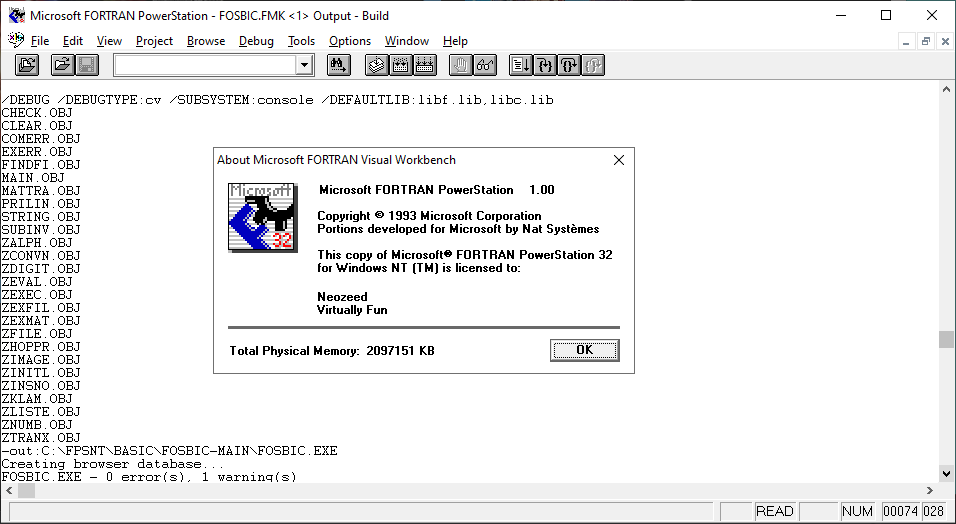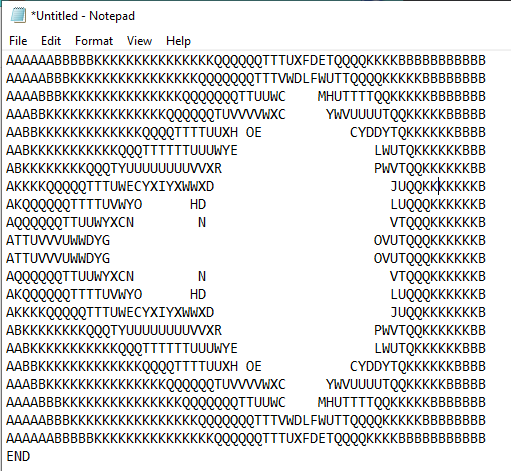Or Basic compiler/system in Fortran IV
I came across fosbic1 on github by accident, so intrigued by the description:
This is the FOSBIC1 compiler developed at the University of Gießen, Germany in the late 70s for the CDC 3300 batch system. It is a BASIC compiler and runtime system which is written in FORTRAN IV. The text book from which the source code was copied implies that it is a modified version of a BASIC compiler named UWBIC from the University of Washington, developed by William Sharp in 1967, for their IBM 7094.
So, without going into it much further I went ahead and made a few minor changes to get it running on Microsoft Fortran

Instead of some boring example, I thought I’d try some Mandelbrot, so going through this collection on rosettacode, I thought the OS/8 version looked simple enough to work with.
Sadly it doesn’t seem to be very ASCII so it doesn’t understand numerical characters. Maybe I’m doing it wrong I didn’t see anything. Just as my attempt to set a string variable to itself + a new letter then print that string strangely failed. Also it does weird stuff with strings, again it maybe me, but I’m impatient. This is terrible, and yeah I know.
TESTCOMPILER -- BASIC BWL 5 GIESSEN -- VERSION 6/76-04
10 X1=59
11 Y1=21
20 I1=-1.0
21 I2=1.0
22 R1=-2.0
23 R2=1.0
30 S1=(R2-R1)/X1
31 S2=(I2-I1)/Y1
40 FOR Y=0 TO Y1
50 I3=I1+S2*Y
60 FOR X=0 TO X1
70 R3=R1+S1*X
71 Z1=R3
72 Z2=I3
80 FOR N=0 TO 30
90 A=Z1*Z1
91 B=Z2*Z2
100 IF A+B>4.0 GOTO 130
110 Z2=2*Z1*Z2+I3
111 Z1=A-B+R3
120 NEXT N
130 REM PRINT CHR$(0062-N);
131 IF N=0 THEN 200
132 IF N=1 THEN 202
133 IF N=10 THEN 204
134 IF N=11 THEN 206
135 IF N=12 THEN 208
136 IF N=14 THEN 210
137 IF N=15 THEN 212
138 IF N=16 THEN 214
139 IF N=17 THEN 216
140 IF N=19 THEN 218
141 IF N=2 THEN 230
142 IF N=20 THEN 232
143 IF N=22 THEN 234
144 IF N=23 THEN 236
145 IF N=24 THEN 238
146 IF N=25 THEN 240
147 IF N=3 THEN 242
148 IF N=30 THEN 244
149 IF N=31 THEN 246
150 IF N=4 THEN 248
151 IF N=5 THEN 250
152 IF N=6 THEN 252
153 IF N=7 THEN 254
154 IF N=8 THEN 256
155 IF N=9 THEN 258
200 PRINT 'A';
201 GOTO 439
202 PRINT 'B';
203 GOTO 439
204 PRINT 'C';
205 GOTO 439
206 PRINT 'D';
207 GOTO 439
208 PRINT 'E';
209 GOTO 439
210 PRINT 'F';
211 GOTO 439
212 PRINT 'G';
213 GOTO 439
214 PRINT 'H';
215 GOTO 439
216 PRINT 'I';
217 GOTO 439
218 PRINT 'J';
219 GOTO 439
230 PRINT 'K';
231 GOTO 439
232 PRINT 'L';
233 GOTO 439
234 PRINT 'M';
235 GOTO 439
236 PRINT 'N';
237 GOTO 439
238 PRINT 'O';
239 GOTO 439
240 PRINT 'P';
241 GOTO 439
242 PRINT 'Q';
243 GOTO 439
244 PRINT 'R';
245 GOTO 439
246 PRINT '-';
247 GOTO 439
248 PRINT 'T';
249 GOTO 439
250 PRINT 'U';
251 GOTO 439
252 PRINT 'V';
253 GOTO 439
254 PRINT 'W';
255 GOTO 439
256 PRINT 'X';
257 GOTO 439
258 PRINT 'Y';
259 GOTO 439
439 REM
440 NEXT X
450 PRINT '-EOL'
460 NEXT Y
461 PRINT 'END'
470 ENDIt runs in batches, so it’s not interactive. Very mainframe/1960’s minicomputer like. I guess it’s fitting again being in FORTRAN.
******************* EVERYTHING SEEMS OK -- LET'S GO AHEAD
PERCENT OF AVAILABLE STORAGE USED 31.081
PERCENT OF AVAILABLE DATA STORAGE USED .000
PERCENT OF AVAILABLE NUMBERED STATEMENTS USED 30.294
AA A A A A B B B B B K K K K K
K K K K K K K K K K Q Q Q Q Q
Q T T T U X F D E T Q Q Q Q K
K K K B B B B B B B B B B B -EOLI’m not sure what is up with the AA and after that, it’s all tabulated. I ended up running it through sed to remove the spaces, and using notepad to stitch the lines together. I guess I could have bash’d it some more but.. I’m impatient.
So yeah, it looks like it worked! Very amazing. And of course it’s crazy fast but that should be expected I suppose. I don’t like the hard coded table, but I just wanted to get it to generate an image.
Sadly, the author of the compiler, Weber seems to have disappeared, and the publisher Paul Haupt died in 1978, a year after this being published.


Interesting, I never heard of this even though I was a PhD student in Marburg, about 30 km north of Gießen (but, of course, decades after that BASIC compiler was written).
Amazingly, this work was done in the economics department – Gießen didn’t have a CS department back then and still today only has two professors working in CS. There’s a German newspaper article on FOSBIC praising the research results at https://www.uni-giessen.de/de/fbz/svc/hrz/org/historie/Dokumente/FOSBIC.pdf
Weber is not mentioned as emeritus professor at the economics department of the university of Gießen, so he might have left Gießen before retiring. According to https://www.jstor.org/stable/24179027 Weber was 61 years old in 1988, so he would be around 96 years old today if he is still alive.
The other person mentioned in the readme is “DIPL.-ING.,DIPL.-OEC.C.W.TUERSCHMANN”. It seems this is Carl Wolfram Türschmann (the name is pretty rare in Germany, you can also find a LinkedIn profile “Wolfram Türschmann” that mentions Gießen uni, so I assume this is him) who also published a textbook on BASIC with Karl Weber (https://doc1.bibliothek.li/abc/A042761.pdf).